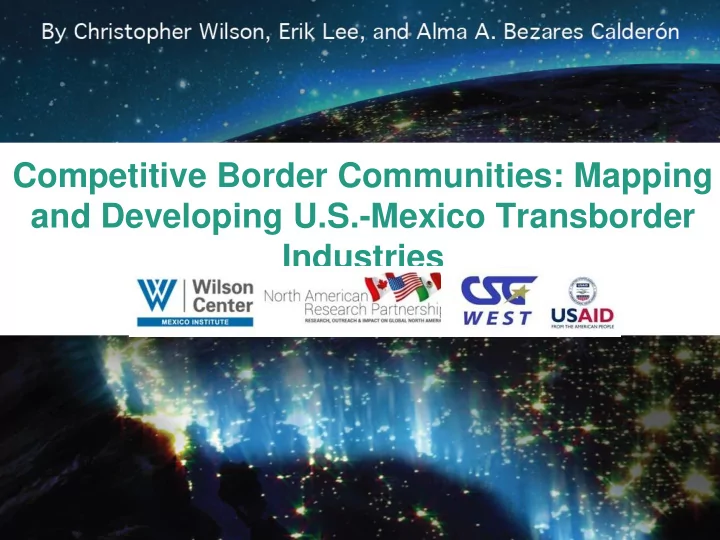

Competitive Border Communities: Mapping and Developing U.S.-Mexico Transborder Industries
Building Cross-Border Supply Chains The Goal: Promoting Economic Development and Competitiveness by Taking Full Advantage of the Assets and Comparative Advantages of All Communities in a Binational Border Region. The Challenge: Overcoming Division and Fragmentation both along and across the border; Moving Toward Cooperation and Coordination
Clusters vs. Industries
Where do Cluster-Based Strategies Fit in to Overall Economic Development? Picking Winners Cluster-Based Strategies Macro and Overall Business Environment Improvements -Firm Specific -Data reveals existing industrial (Cross-Cluster Strategies) clusters with roots (not -Weakens Competition and politically driven) -Subregion, Region or Nation thus incentives to improve specific -Industry/Cluster specific -Politically driven -Pro-competition (robust -Pro-competition (seeks business environment fosters -Inconsistent across diversity and numerous firms competition) administrations competing within sector) Examples: Education, Examples: Subsidies, Tariff Examples: Specialized Responsible Fiscal and Barriers, Negotiated tax Education Programs, Industry Monetary Policy, Trade incentives Worker Training Programs, Liberalization, Cutting Red- Specialized Infrastructure (port, Tape, Simplifying Tax Code, pre-inspection), Business- General Infrastructure (overall Regulator Dialogue, Joint highway network, broadband, Marketing etc.), Broad tax incentives
What We Did: Binational Industry Mapping Methodology Concentration: Location Quotient compares local • concentration of jobs in an industry to national/binational employment. • Dynamic: Competitiveness Index of Shift-Share Analysis identifies industries growing faster locally than in the broader economy. • Binational: Bilateral Export Intensity , exports/GDP at the state-level. • Qualitative Data: Gathered at focus group sessions with stakeholders from both sides of the border in San Diego, Tucson, El Paso, and Brownsville.
What We Found: Border-Wide Findings Highly specialized manufacturing industries on the Mexican side of the border. Strong logistics industries on the U.S. side Fewer signs of deep supply chain connections or non-logistics service provision by U.S. firms along the border to Mexican border industries than we had expected. Highly uneven nature of cluster organization and crossborder economic development efforts throughout the border region. The predominance of border security over trade has affected the overall business environment at the border. Highly uneven distribution of manufacturing operations poses a challenge for the cultivation of binational clusters. Crossborder mobility and human capital development continues to be a challenge in the region.
Automotive Sector
Parts Manufacturing Employment
Aerospace Industry
Aerospace Industry
Transportation, Logistics, and Trade
Logistics Sector: General Freight Trucking Employment
Main Recommendation Border communities should actively utilize cluster-based economic development, with its focus on collaboration among government, industry and educational institutions, as an opportunity to engage federal officials managing the border as partners in a joint effort.
Managing Border “Collab - etition” • Challenge 1: East to West collaboration Geographical challenge of the border region • Jurisdictional challenge • Perceived competition between regions • A new approach: #oneborder (private sector) • • Goal = share best practices. • Challenge 2: North to South collaboration Working across/through a “thick” border • Mega Region approach: BorderPlex, CaliBaja • • Challenge 3: Local competition > local collaboration Scarce resources, duplicative programs
A Key Challenge Building Cross-border Economic Development at the LOCAL Level
A Collective Impact Model for Crossborder Economic Development? • Collective Impact approach to solving complex problems (v. simple or complicated) • Key ingredients: common agenda, shared goal, mutually reinforcing activities, continuous communication, backbone organizations. • Step 1: Agree on a collective goal.
Make Your Own Maps naresearchpartnership.org/projects/binationalindustries/map wilsoncenter.org/specialinitiatives/binationalindustries
Recommend
More recommend